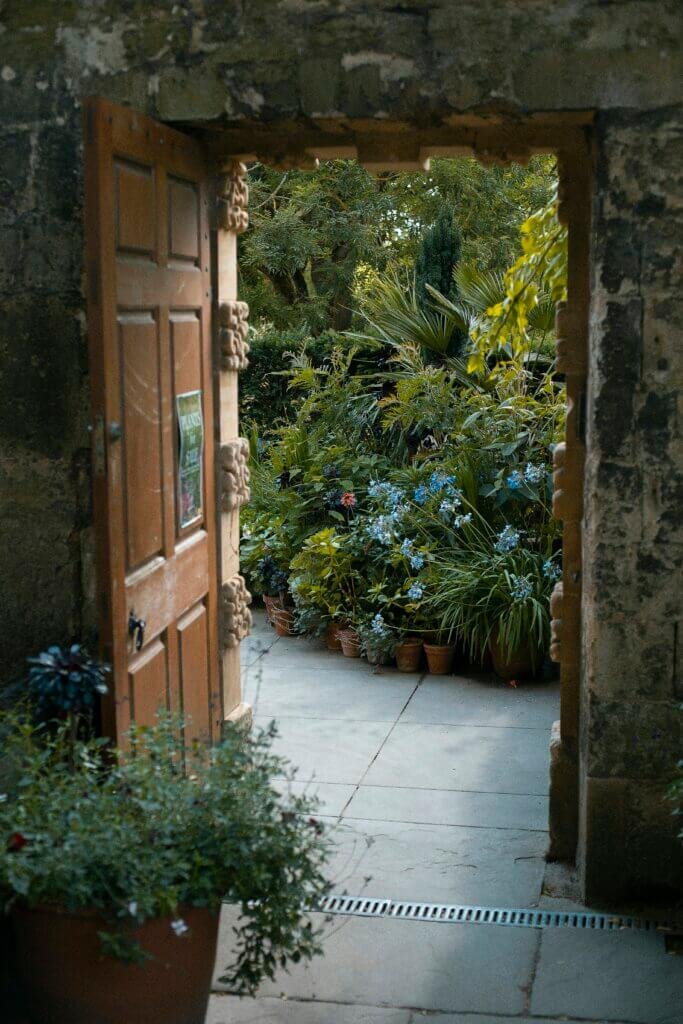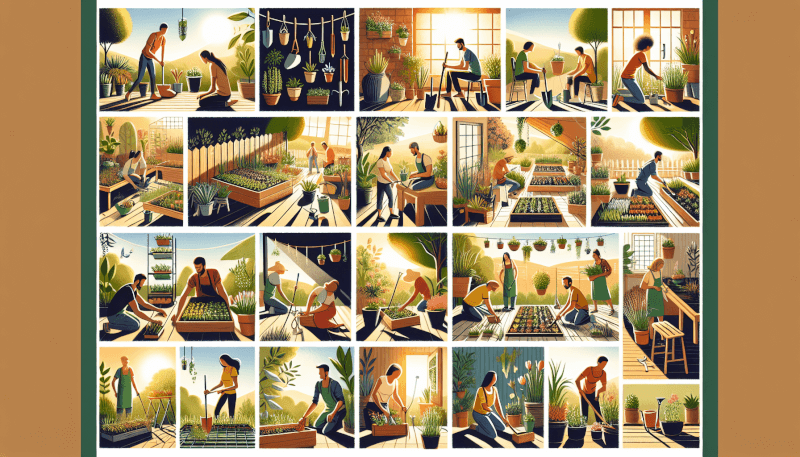If you’re a busy gardener looking for simple yet effective ways to enhance your garden, then this article is for you. In “Quick And Easy DIY Garden Projects For Busy Gardeners,” we’ll explore a variety of creative and time-saving ideas to help transform your outdoor space into a vibrant oasis. From practical tips on container gardening to innovative ways to repurpose everyday items, you’ll discover how to make the most of your limited time while still enjoying a beautiful and thriving garden. So, let’s roll up our sleeves and get ready to embark on a journey of quick and easy garden projects that will leave you with stunning results.

Designing a low-maintenance garden
Choosing low-maintenance plants
When designing a low-maintenance garden, it’s important to select plants that require minimal care and attention. Opt for hardy and drought-tolerant varieties that can thrive in your specific climate. Native plants are often a great choice as they are well-adapted to the local conditions and require less watering and maintenance. Consider perennial plants that come back year after year, reducing the need for replanting. Additionally, choose plants with a long blooming season to ensure continuous beauty in your garden without the constant need for planting new flowers.
Creating defined borders
Defining the borders of your garden not only adds structure and aesthetics but also helps in minimizing the maintenance required. Use materials such as decorative stones, bricks, or wooden edging to create clear boundaries between your garden and other areas. These borders can help contain garden beds, prevent grass or weeds from encroaching, and make mowing or trimming easier. Well-defined borders also provide a neat and tidy appearance, giving your low-maintenance garden a polished look.
Implementing weed control measures
Weeds can quickly take over a garden, demanding constant attention and maintenance. To minimize weed growth, start by preparing the soil properly before planting. Remove any existing weeds and their roots and add a layer of mulch, such as wood chips or straw, on top of the soil. Mulch acts as a natural weed barrier, suppressing weed growth by blocking out sunlight and preventing weed seeds from germinating. Regularly inspect your garden for any emerging weeds and promptly remove them before they have a chance to spread.
Creating custom planters and garden beds
Repurposing household items as planters
Creating custom planters from household items is not only a fun and creative project but also a sustainable way to add unique elements to your garden. Consider repurposing old buckets, containers, or even unused furniture as planters. For example, an old wooden ladder can be transformed into a vertical herb garden by adding plant pots to each step. Get creative and let your imagination run wild – the opportunities for unique and personalized planters are endless.
Building raised garden beds
Raised garden beds not only provide a visually appealing element to your garden but also offer practical benefits. They provide better drainage, prevent soil compaction, and make it easier to control the quality of the soil. Building raised garden beds can be as simple as stacking wooden planks or using concrete blocks to create the desired shape and height. Fill the beds with a mixture of compost, peat moss, and garden soil for optimal plant growth. Raised garden beds also make it easier to reach the plants without bending over, reducing strain on your back and knees.
Constructing vertical garden structures
Vertical gardening is an excellent space-saving solution for those with limited garden space. By utilizing vertical structures such as trellises, fences, or even old ladders, you can create a stunning display of plants that not only adds beauty but also reduces the need for ground space. Vining plants such as tomatoes, cucumbers, and climbing roses can be trained to grow vertically, maximizing your garden’s productivity. Ensure that the structure you choose is sturdy enough to support the weight of the plants and provide them with adequate support as they grow.

Installing automatic irrigation systems
Choosing the right irrigation system
When it comes to low-maintenance gardening, installing an automatic irrigation system is a game-changer. There are various options available, including drip irrigation, soaker hoses, and sprinkler systems. Drip irrigation is particularly well-suited for low-maintenance gardens as it delivers water directly to the plant’s root zone, minimizing evaporation and reducing water waste. Consider factors such as your garden size, plant watering requirements, and water source availability when choosing the right irrigation system for your needs.
Installing drip irrigation
Drip irrigation systems consist of a network of tubes or hoses with tiny emitters that slowly release water directly to the base of the plants. This targeted watering technique ensures that water is distributed efficiently, reducing water consumption and minimizing weed growth. Install the drip irrigation system by laying out the hoses or tubes along the plants, making sure to position the emitters near the root zone. Use stakes or clips to secure the tubing in place and connect it to a timer or water source for automated watering.
Setting up a timer system
A timer system is an essential component of an automatic irrigation system that allows you to set specific watering schedules for your garden. Once your drip irrigation system is installed, connect it to an electronic timer that controls when and how long the irrigation system operates. This eliminates the need for manual watering, ensuring your garden receives the right amount of water at the appropriate times even when you’re away or have a busy schedule. Set the timer to water your plants during the early morning or late evening when evaporation rates are lower, maximizing water efficiency.
Building a composting system
Selecting the right composting method
Composting is a valuable practice that not only reduces waste but also provides nutrient-rich compost for your garden. When designing a low-maintenance garden, it’s important to select a composting method that suits your lifestyle and space constraints. Traditional backyard composting, vermicomposting (using worms), or compost tumblers are popular options. Assess the volume of organic waste you generate, the available space in your garden, and the amount of time you can dedicate to managing the composting process to determine the most suitable method for you.
Constructing a compost bin
To construct a compost bin, repurpose materials such as wooden pallets, wire mesh, or plastic containers. Design a bin that allows proper aeration and drainage to facilitate the decomposition process effectively. Consider a three-bin system, where organic waste moves through different stages of decomposition, allowing you to have a continuous supply of compost. Place the compost bin in a convenient location in your garden, preferably near the area where you plan to use the finished compost.
Managing compost materials
To maintain a low-maintenance composting system, ensure you strike the right balance between brown (carbon-rich) and green (nitrogen-rich) materials. Brown materials include dry leaves, straw, and shredded paper, while green materials consist of kitchen scraps, fresh grass clippings, and plant trimmings. Layer these materials in the compost bin, alternating between the two types to promote decomposing organisms’ activity. Regularly turn the compost to aerate it and speed up the decomposition process. Keep the compost moist, but not soggy, by watering it occasionally, and avoid adding any meat, dairy products, or oils that can attract pests and slow down the decomposition.

Creating DIY garden decor
Designing and painting garden signs
Personalize your low-maintenance garden by designing and painting your own garden signs. Use weather-resistant materials such as wood, metal, or plastic to create durable signs that can withstand outdoor conditions. Choose paint colors and designs that reflect your personality or complement the overall theme of your garden. Whether you opt for humorous quotes, plant labels, or directional signs, these custom-made garden signs offer a creative touch that will delight visitors and add an extra element of charm to your outdoor space.
Crafting wind chimes from recycled materials
Wind chimes not only create a soothing sound but also add visual interest to your garden. Get creative by crafting your own wind chimes using recycled materials such as seashells, old utensils, or even wine bottles. Collect materials that create different tones and textures when they collide, and assemble them using sturdy string or wire. Hang your DIY wind chimes in areas where they can catch the breeze, bringing delightful melodies to your low-maintenance garden.
Building trellises and arbors
Trellises and arbors serve both functional and aesthetic purposes in a garden. They provide support for climbing plants, such as beans or ivy, while adding vertical elements that create visual appeal. Build trellises using materials such as bamboo poles, wooden frames, or wire mesh, ensuring they are sturdy and can withstand the weight of the plants. Arbors, on the other hand, offer an entrance or focal point for your garden. Construct them using materials like wood or metal, and consider adding climbing roses or vines for a breathtaking display.
Constructing a DIY greenhouse
Choosing the right location and materials
If you’re serious about gardening, a DIY greenhouse can significantly extend your growing season and offer a controlled environment for your plants. Start by selecting an ideal location that receives ample sunlight and is protected from strong winds. Consider materials such as PVC pipes, wooden frames, or reclaimed windows for constructing the greenhouse structure. Ensure the materials are durable, weather-resistant, and provide adequate insulation to maintain appropriate temperature and humidity levels within the greenhouse.
Building a simple hoop greenhouse
A simple and cost-effective option for a DIY greenhouse is a hoop greenhouse. This design features a curved frame made of PVC pipes or metal hoops covered with greenhouse plastic or polyethylene. Assemble the frame by bending the pipes or hoops into arches and securing them to the ground using stakes or metal brackets. Cover the frame with the greenhouse plastic, ensuring it is taut and secured to prevent any drafts or damage from inclement weather. Add doors or vents for access and ventilation, allowing for temperature control and airflow as needed.
Installing proper ventilation
Proper ventilation is crucial for maintaining a healthy and productive greenhouse environment. Install vents or windows that can be opened and closed to control temperature, humidity, and air circulation. Consider automatic vent openers that respond to changes in temperature, ensuring optimal conditions for your plants even when you’re not present. Additionally, add fans or exhaust systems to promote air movement and prevent the development of mold or fungus. Good ventilation helps regulate temperature, reduce pest problems, and encourage strong and healthy plant growth within your DIY greenhouse.

Designing a container garden
Selecting the right containers
Container gardening is an excellent option for those with limited space or wanting to add versatility to their low-maintenance garden. When selecting containers, consider both functionality and aesthetics. Choose containers made of durable materials such as terracotta, plastic, or fiberglass, ensuring they have proper drainage holes to prevent waterlogging. Opt for containers of various sizes and shapes to accommodate different types of plants and create visual interest.
Choosing appropriate plants for containers
Not all plants thrive in containers, so it’s important to choose suitable varieties for your container garden. Consider the mature size of the plants, their sunlight and water requirements, and whether they are suitable for the specific container size and environment. Herbs, lettuces, flowers, and even dwarf fruit trees are great options for container gardening. Remember to group plants with similar needs together, ensuring they receive adequate care and thrive in their confined space.
Implementing proper watering techniques
Container plants have specific watering needs that differ from those grown in the ground. The limited soil volume in containers means they dry out more quickly and require more frequent watering. To maintain a low-maintenance container garden, consider using self-watering containers or installing drip irrigation specifically designed for pots. These systems provide consistent moisture to the plants’ roots, reducing the need for daily watering. Regularly monitor the moisture levels and adjust your watering schedule accordingly to keep your container garden thriving without excessive effort.
Creating a pollinator-friendly garden
Planting flowers that attract pollinators
Pollinators such as bees, butterflies, and hummingbirds play a crucial role in the garden ecosystem. To create a pollinator-friendly garden, choose flowers that provide nectar and pollen as food sources for these essential creatures. Select a variety of flowering plants that bloom at different times throughout the year to ensure a continuous food supply. Include native wildflowers and flowering herbs such as lavender, sunflowers, and coneflowers to attract a diverse range of pollinators to your garden.
Building simple insect hotels
Insect hotels, also known as bug houses or bee hotels, are structures designed to provide nesting sites for beneficial insects. These hotels offer shelter and protection for solitary bees, ladybugs, and other beneficial insects that aid in pollination and pest control. Build your own insect hotel using natural materials such as bamboo sticks, pinecones, or hollow plant stems. Stack the materials in a sturdy frame, creating small cavities and crevices for insects to inhabit. Place the insect hotel in a sunny spot in your garden to attract and support these helpful pollinators.
Implementing a water source for pollinators
Water is essential for pollinators, especially during hot and dry periods. Create a water source in your garden to attract and provide a drinking spot for these beneficial insects. Use shallow dishes or bowls and fill them with water, adding floating objects such as pebbles or twigs to provide landing spots. Ensure the water is refreshed regularly to prevent stagnation and discourage breeding of mosquitoes. A simple water source not only supports pollinators but also adds an aesthetic element to your low-maintenance garden.

Implementing a garden lighting system
Choosing energy-efficient lighting options
A garden lighting system not only enhances the beauty of your garden but also extends its usability into the evening hours. Opt for energy-efficient lighting options such as LED (light-emitting diode) bulbs or solar-powered lights to minimize energy consumption and reduce maintenance. LED lights are long-lasting and produce bright illumination while consuming less electricity. Solar-powered lights harness the sun’s energy during the day and automatically illuminate your garden at night, eliminating the need for wiring or electricity.
Installing solar-powered garden lights
Solar-powered garden lights are a practical and eco-friendly way to illuminate your low-maintenance garden. These lights absorb sunlight during the day using built-in solar panels and store the energy in rechargeable batteries. As darkness falls, the lights automatically turn on, casting a warm and inviting glow throughout your garden. Install the solar lights along pathways, near focal points, or around seating areas to create a cozy and magical atmosphere while reducing your carbon footprint.
Creating a cozy ambiance with string lights
String lights are a versatile and charming addition to any garden. Hang them overhead along fences, pergolas, or trees to create a romantic and cozy ambiance. Opt for weather-resistant string lights with LED bulbs for both energy efficiency and durability. Choose warm white or soft yellow bulbs to create a gentle and inviting glow that complements the natural beauty of your low-maintenance garden. String lights are perfect for entertaining guests, enjoying a quiet evening outdoors, or simply adding a touch of enchantment to your outdoor space.
Implementing vertical gardening techniques
Building a vertical herb garden
Vertical herb gardens are a practical solution for gardeners who want fresh herbs without taking up much space. Construct a vertical herb garden using wall-mounted planters, hanging pots, or even repurposed pallets. Fill the containers with well-draining soil and plant herbs such as basil, thyme, and mint. Position the vertical herb garden in a sunny spot near your kitchen for easy access to fresh herbs for culinary delights. Vertical herb gardens not only save space but also add visual interest and a delightful aroma to your low-maintenance garden.
Growing plants on a trellis or fence
Make use of your garden’s vertical space by training plants to grow on trellises or fences. Climbing plants such as jasmine, clematis, or grapevines can be guided and supported on trellises or wire mesh attached to fences. This technique not only adds height and dimension to your garden but also maximizes your planting space. Ensure the trellis or fence is securely installed and can handle the weight of the climbing plants. As the plants grow, gently train them to climb the support structure, creating a lush and vibrant vertical display.
Utilizing vertical space with hanging baskets
Hanging baskets are perfect for adding a splash of color and greenery to your low-maintenance garden. Utilize vertical space by hanging baskets from pergolas, tree branches, or hooks attached to fences or walls. Choose plants with trailing or cascading growth habits, such as petunias, begonias, or ivy, to create stunning displays that soften the vertical lines in your garden. Ensure the hanging baskets have proper drainage and use a high-quality potting mix to provide the necessary nutrients for healthy plant growth. Water the baskets regularly and feed them with a balanced liquid fertilizer to keep the plants flourishing throughout the growing season.
In conclusion, designing a low-maintenance garden requires careful planning and consideration of various factors. By choosing low-maintenance plants, creating defined borders, implementing weed control measures, and incorporating custom planters and garden beds, you can reduce the amount of time and effort required for garden upkeep. Installing automatic irrigation systems, building a composting system, and utilizing vertical gardening techniques further enhance the efficiency and sustainability of your garden. Adding DIY garden decor, constructing a DIY greenhouse, and creating a container garden allow you to personalize your outdoor space and accommodate specific gardening needs. Designing a pollinator-friendly garden, implementing a garden lighting system, and utilizing vertical gardening techniques provide additional benefits while maximizing the beauty and functionality of your low-maintenance garden. With these tips and ideas, busy gardeners can enjoy a thriving and visually pleasing garden without compromising their limited time and energy.


